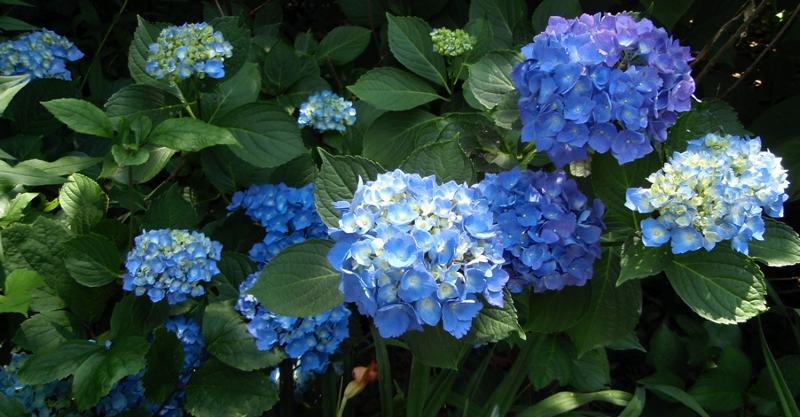 Blue is cool in the garden Blue is cool in the garden~~~~~~~~~~~~~~~~~~~~~~~~~~~~~~~~~~~~~~~~~~~~~~~~
Vitex is blooming! I love blue flowers, so I think that vitex (Vitex agnus-castus) is one of the prettiest of all our 'late summer' blooming plants. It usually flowers in August with the crepe myrtle and butterfly bushes. This year it is early and was bloom for July 4th. However, the way this tree blooms it goes on and on, as there are clusters of buds in many stages. Ours is large and beautiful and such a good companion for a bright red crepe myrtle. This easy to grow shrub is such a good choice for awesome summer color. When the spent blooms are cut off it may bloom again. There is faint lavender like fragrance in both leaves and flowers of vitex. The butterflies and hummingbirds love the blooms even more than I do. Vitex thrives in sunny conditions, with plenty of water, but at the same time, it grows well in drier environments and part shade conditions too. Most of ours are in sandy places of part shade. They are the most awesome plants in bloom now. Vitex is known as tough and hardy and really easy to grow. Vitex sheds all its leaves during the winter months, but has the interest of clusters of brown berries. This colorful blue blooming plant was often referred to as 'chaste tree' by the Victorians and as monk's berry during the middle Ages. Legend said it suppressed libido, but it was also used to treat various hormone deficiencies. Who knows? (Plant folk tales are fun!) Some scholars like Hippocrates are known to have recommended using the 'chaste tree' for treating conditions like injuries and inflammation, and several centuries later Dioscorides is known to have recommended the herb exclusively for treating inflammation of the womb and for encouraging milk flow shortly after birth. The medicinal part of the plant is the berry that forms after the blooms fade. In Rome, vestal virgins carried twigs of chaste tree as a symbol of chastity. The seeds were once called monk's pepper and were used among early monks as help against the evils of the fleshy desires. For thousands of years it has been an important part of medical applications and even today studies are being done in Germany on the uses of this plant. However, I recommend that you plant one for its lush blue blooms that look so pretty in your garden. Hydrangea  The cool blue of hydrangea is also pretty in a summer and fall garden. Remember, as their name indicates a hydrangea needs lots of water to bloom and look beautiful. They appreciate some compost in the soil, a good drink several times a week and a light mulch to keep them moist. Let a hose or soaker thoroughly wet the soil to the bottom of the roots. Overhead sprinkling will sometimes ruin the blooms and mar the leaves on most plants. Soaker hose or drip irrigation work well. To change pink bloom to blue adds acid or aluminum sulfate to the soil. This may take a while to work, but it really works. It will not change color of white ones. There are many kinds of hydrangea; some of the late blooming cone shaped white blooms dry the best. If you have sun or shade these plants do well and add constant bloom for a long period of time. Butterfly Bush Fragrant nectar place for butterflies to visit. 
Swallowtail drinks nectar from butterfly bush! Butterfly bushes (Buddleia) are very vibrant and also bloom from now until frost. The more you deadhead the spent blooms the more they will bloom. If you plant this in full sun you will have the most blooms, but they will grow in part shade too. Remember they do not want to sit in muddy, clay, poorly drained soil. The blooms have an intoxicating scent that lures butterflies, hummingbirds and people to their vicinity. I love to pick a bouquet for my kitchen table. They can be found in white, deep pink, wine, and many shades of purple. Most get 5 -6 feet tall, but can be cut in half. They continue to produce blooms all the time with just a little fertilizer. 
So if you do not have these summer bloomers plant some now. There is always room for a few more plants in your garden. Email Lorraine@tripleoaks.com to ask your garden questions. You may set up an appointment to bring in garden photos and get suggestions on plants for year round color in your garden. .
|